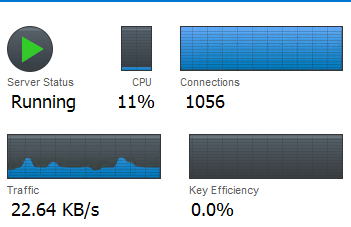 Autor Autor
|
Tema: Error Mysql remoto ¿Muchas peticiones? (Leído 2,857 veces)
|
WIитX
 Desconectado Desconectado
Mensajes: 1.026
WINTX


|
Hola chicos tengo 2 servidores, en el segundo tengo un servidor mysql que conecta con mi primer servidor pero al tener un poco de "ajetreo" la web me tira el siguiente error Warning: mysql_connect(): Can't create a new thread (errno -1); if you are not out of available memory, you can consult the manual for a possible OS-dependent bug in /home/u460628185/public_html/miconexioncondb.php on line 33 Warning: mysql_select_db() expects parameter 2 to be resource, boolean given in /home/u460628185/public_html/miconexioncondb.php on line 34 Warning: mysql_query(): Access denied for user 'usuario'@'ip' (using password: NO) in /home/u460628185/public_html/miconexioncondb.php on line 35 Warning: mysql_query(): A link to the server could not be established in /home/u460628185/public_html/miconexioncondb.php on line 35
|
|
|
|
|
 En línea
En línea
|
"Es más divertido hacerse pirata que unirse a la marina." (Steve Jobs) |
|
|
|
engel lex
|
para ver tu configuración de my.cnf
|
|
|
|
« Última modificación: 5 Enero 2017, 16:15 pm por engel lex »
|
 En línea
En línea
|
El problema con la sociedad actualmente radica en que todos creen que tienen el derecho de tener una opinión, y que esa opinión sea validada por todos, cuando lo correcto es que todos tengan derecho a una opinión, siempre y cuando esa opinión pueda ser ignorada, cuestionada, e incluso ser sujeta a burla, particularmente cuando no tiene sentido alguno.
|
|
|
WIитX
 Desconectado Desconectado
Mensajes: 1.026
WINTX


|
para ver tu configuración de my.cnf
He probado ya muchas cosas xd # MySQL Server Instance Configuration File
# ----------------------------------------------------------------------
# Generated by the MySQL Server Instance Configuration Wizard
#
#
# Installation Instructions
# ----------------------------------------------------------------------
#
# On Linux you can copy this file to /etc/my.cnf to set global options,
# mysql-data-dir/my.cnf to set server-specific options
# (@localstatedir@ for this installation) or to
# ~/.my.cnf to set user-specific options.
#
# On Windows you should keep this file in the installation directory
# of your server (e.g. C:\Program Files\MySQL\MySQL Server X.Y). To
# make sure the server reads the config file use the startup option
# "--defaults-file".
#
# To run run the server from the command line, execute this in a
# command line shell, e.g.
# mysqld --defaults-file="C:\Program Files\MySQL\MySQL Server X.Y\my.ini"
#
# To install the server as a Windows service manually, execute this in a
# command line shell, e.g.
# mysqld --install MySQLXY --defaults-file="C:\Program Files\MySQL\MySQL Server X.Y\my.ini"
#
# And then execute this in a command line shell to start the server, e.g.
# net start MySQLXY
#
#
# Guildlines for editing this file
# ----------------------------------------------------------------------
#
# In this file, you can use all long options that the program supports.
# If you want to know the options a program supports, start the program
# with the "--help" option.
#
# More detailed information about the individual options can also be
# found in the manual.
#
#
# CLIENT SECTION
# ----------------------------------------------------------------------
#
# The following options will be read by MySQL client applications.
# Note that only client applications shipped by MySQL are guaranteed
# to read this section. If you want your own MySQL client program to
# honor these values, you need to specify it as an option during the
# MySQL client library initialization.
#
[client]
port=3306
[mysql]
default-character-set=latin1
# SERVER SECTION
# ----------------------------------------------------------------------
#
# The following options will be read by the MySQL Server. Make sure that
# you have installed the server correctly (see above) so it reads this
# file.
#
[mysqld]
# The TCP/IP Port the MySQL Server will listen on
port=3306
bind-address=0.0.0.0
#Path to installation directory. All paths are usually resolved relative to this.
basedir="C:/Program Files (x86)/MySQL/MySQL Server 5.5/"
#Path to the database root
datadir="C:/ProgramData/MySQL/MySQL Server 5.5/Data/"
# The default character set that will be used when a new schema or table is
# created and no character set is defined
character-set-server=latin1
# The default storage engine that will be used when create new tables when
default-storage-engine=INNODB
# Set the SQL mode to strict
sql-mode="STRICT_TRANS_TABLES,NO_AUTO_CREATE_USER,NO_ENGINE_SUBSTITUTION"
# The maximum amount of concurrent sessions the MySQL server will
# allow. One of these connections will be reserved for a user with
# SUPER privileges to allow the administrator to login even if the
# connection limit has been reached.
max_connections=999999
# Query cache is used to cache SELECT results and later return them
# without actual executing the same query once again. Having the query
# cache enabled may result in significant speed improvements, if your
# have a lot of identical queries and rarely changing tables. See the
# "Qcache_lowmem_prunes" status variable to check if the current value
# is high enough for your load.
# Note: In case your tables change very often or if your queries are
# textually different every time, the query cache may result in a
# slowdown instead of a performance improvement.
query_cache_size=0
# The number of open tables for all threads. Increasing this value
# increases the number of file descriptors that mysqld requires.
# Therefore you have to make sure to set the amount of open files
# allowed to at least 4096 in the variable "open-files-limit" in
# section [mysqld_safe]
table_cache=256
# Maximum size for internal (in-memory) temporary tables. If a table
# grows larger than this value, it is automatically converted to disk
# based table This limitation is for a single table. There can be many
# of them.
tmp_table_size=103M
# How many threads we should keep in a cache for reuse. When a client
# disconnects, the client's threads are put in the cache if there aren't
# more than thread_cache_size threads from before. This greatly reduces
# the amount of thread creations needed if you have a lot of new
# connections. (Normally this doesn't give a notable performance
# improvement if you have a good thread implementation.)
thread_cache_size = 50
#*** MyISAM Specific options
# The maximum size of the temporary file MySQL is allowed to use while
# recreating the index (during REPAIR, ALTER TABLE or LOAD DATA INFILE.
# If the file-size would be bigger than this, the index will be created
# through the key cache (which is slower).
myisam_max_sort_file_size=100G
# If the temporary file used for fast index creation would be bigger
# than using the key cache by the amount specified here, then prefer the
# key cache method. This is mainly used to force long character keys in
# large tables to use the slower key cache method to create the index.
myisam_sort_buffer_size=400M
# Size of the Key Buffer, used to cache index blocks for MyISAM tables.
# Do not set it larger than 30% of your available memory, as some memory
# is also required by the OS to cache rows. Even if you're not using
# MyISAM tables, you should still set it to 8-64M as it will also be
# used for internal temporary disk tables.
key_buffer_size=500M
# Size of the buffer used for doing full table scans of MyISAM tables.
# Allocated per thread, if a full scan is needed.
read_buffer_size=64K
read_rnd_buffer_size=256K
# This buffer is allocated when MySQL needs to rebuild the index in
# REPAIR, OPTIMZE, ALTER table statements as well as in LOAD DATA INFILE
# into an empty table. It is allocated per thread so be careful with
# large settings.
sort_buffer_size=256K
#*** INNODB Specific options ***
# Use this option if you have a MySQL server with InnoDB support enabled
# but you do not plan to use it. This will save memory and disk space
# and speed up some things.
#skip-innodb
# Additional memory pool that is used by InnoDB to store metadata
# information. If InnoDB requires more memory for this purpose it will
# start to allocate it from the OS. As this is fast enough on most
# recent operating systems, you normally do not need to change this
# value. SHOW INNODB STATUS will display the current amount used.
innodb_additional_mem_pool_size=7M
# If set to 1, InnoDB will flush (fsync) the transaction logs to the
# disk at each commit, which offers full ACID behavior. If you are
# willing to compromise this safety, and you are running small
# transactions, you may set this to 0 or 2 to reduce disk I/O to the
# logs. Value 0 means that the log is only written to the log file and
# the log file flushed to disk approximately once per second. Value 2
# means the log is written to the log file at each commit, but the log
# file is only flushed to disk approximately once per second.
innodb_flush_log_at_trx_commit=1
# The size of the buffer InnoDB uses for buffering log data. As soon as
# it is full, InnoDB will have to flush it to disk. As it is flushed
# once per second anyway, it does not make sense to have it very large
# (even with long transactions).
innodb_log_buffer_size=3499K
# InnoDB, unlike MyISAM, uses a buffer pool to cache both indexes and
# row data. The bigger you set this the less disk I/O is needed to
# access data in tables. On a dedicated database server you may set this
# parameter up to 80% of the machine physical memory size. Do not set it
# too large, though, because competition of the physical memory may
# cause paging in the operating system. Note that on 32bit systems you
# might be limited to 2-3.5G of user level memory per process, so do not
# set it too high.
innodb_buffer_pool_size=339M
# Size of each log file in a log group. You should set the combined size
# of log files to about 25%-100% of your buffer pool size to avoid
# unneeded buffer pool flush activity on log file overwrite. However,
# note that a larger logfile size will increase the time needed for the
# recovery process.
innodb_log_file_size=170M
# Number of threads allowed inside the InnoDB kernel. The optimal value
# depends highly on the application, hardware as well as the OS
# scheduler properties. A too high value may lead to thread thrashing.
innodb_thread_concurrency=20
thread_concurrency = 500
No para de subir 
|
|
|
|
« Última modificación: 5 Enero 2017, 22:49 pm por WIитX »
|
 En línea
En línea
|
"Es más divertido hacerse pirata que unirse a la marina." (Steve Jobs) |
|
|
|
| Mensajes similares |
|
Asunto |
Iniciado por |
Respuestas |
Vistas |
Último mensaje |

|

|
conexion a mysql remoto
Bases de Datos
|
diego_lp
|
8
|
12,713
|
 23 Febrero 2010, 01:43 am
23 Febrero 2010, 01:43 am
por ^Tifa^
|

|

|
MySql remoto??
GNU/Linux
|
<<<-Basura->>>
|
0
|
2,088
|
 30 Marzo 2012, 19:14 pm
30 Marzo 2012, 19:14 pm
por <<<-Basura->>>
|

|

|
Hay alguna manera de hacer un chat sin hacer muchas peticiones al servidor?
Desarrollo Web
|
70N1
|
0
|
2,178
|
 20 Marzo 2013, 01:27 am
20 Marzo 2013, 01:27 am
por 70N1
|

|

|
Inyeccion sql, el servidor me impide el acceso tras muchas peticiones seguidas
Hacking
|
ukraniano
|
0
|
2,312
|
 27 Diciembre 2013, 18:42 pm
27 Diciembre 2013, 18:42 pm
por ukraniano
|

|

|
VB.Net Mysql remoto.
.NET (C#, VB.NET, ASP)
|
#Aitor
|
0
|
2,200
|
 10 Mayo 2014, 11:20 am
10 Mayo 2014, 11:20 am
por #Aitor
|
 |





 Autor
Autor




 En línea
En línea





